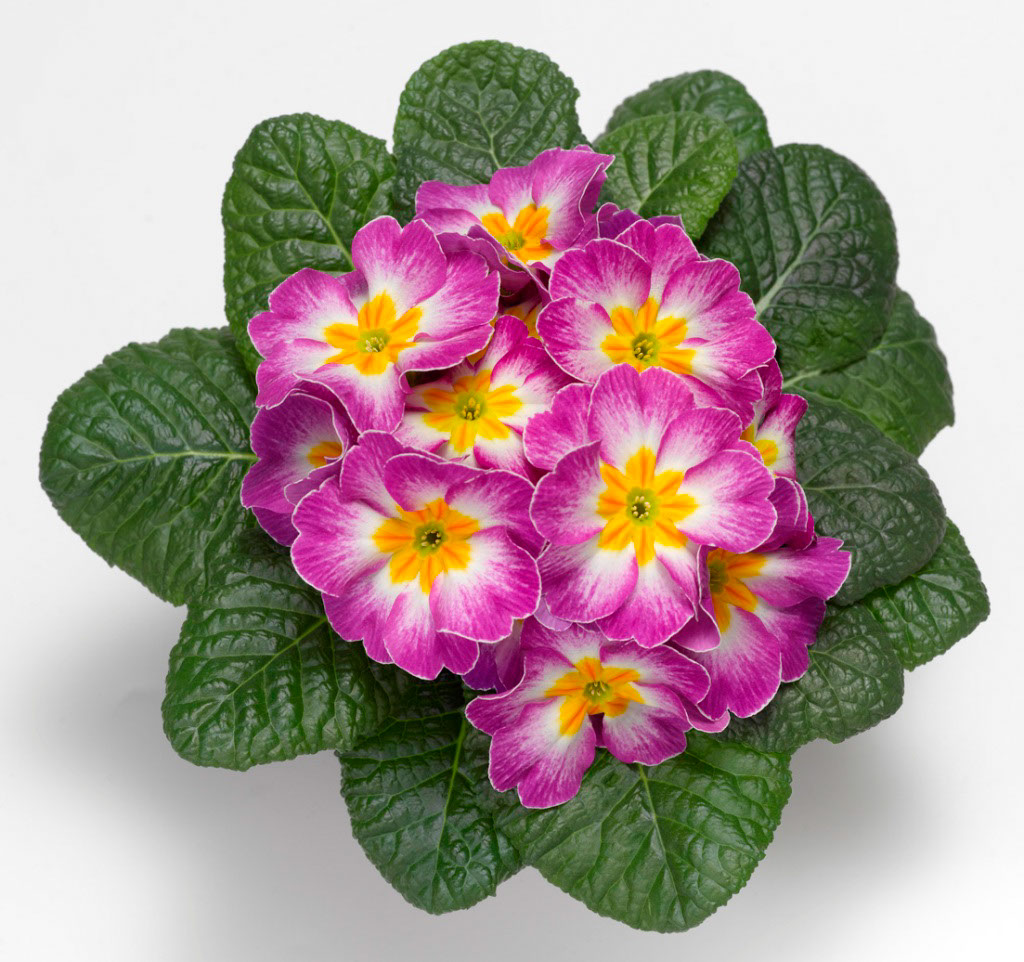Primrose is not only a beautiful, but also a rather unpretentious plant, because it can be grown outdoors and at home. The primrose pleases gardeners with early flowering, since its flowers open at the moment when the last snow melts.
Because of this feature, primroses are considered harbingers of spring. At such moments, the moist dark earth looks very beautiful, which is decorated with blossoming primrose flowers.
Content
Features of growing primroses
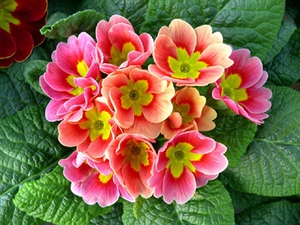 Primrose belongs to the group of perennial plants, so it can be grown in the same place for several years. If it is grown in a summer cottage, then after 7 years you need to think about a transplant.
Primrose belongs to the group of perennial plants, so it can be grown in the same place for several years. If it is grown in a summer cottage, then after 7 years you need to think about a transplant.
You definitely need to spend here division of small outlets, otherwise the primrose flowers will subsequently begin to shrink, the plants will degenerate, and the root system will weaken.
In natural conditions, primrose can often be found in damp, shady places... Its root system is close to the surface, so drying out of the topsoil negatively affects plant development. This must be remembered when growing primroses on a plot or in an apartment.
Reproduction of primroses
 To obtain new primrose bushes, you can use the following methods: cuttings, sowing seeds, dividing the rosette. You can also propagate by rooting, involving immersion in the ground of a cutting with an axillary segment bud.
To obtain new primrose bushes, you can use the following methods: cuttings, sowing seeds, dividing the rosette. You can also propagate by rooting, involving immersion in the ground of a cutting with an axillary segment bud.
Method reproduction by dividing the socket received the greatest distribution due to its simplicity. To do this, you need to dig up a primrose bush, use a knife to divide it into groups or sockets.
In some cases, it is possible to separate the sockets directly from the ground, however, this must be done very carefully. For successful survival, it is recommended to use this breeding method in early spring.
Novice growers are advised to use any of the first three methods, which usually ensure good survival of primrose bushes. But there are situations when you have to use the breeding method sowing seeds... However, even experienced gardeners can face difficulties here.
When using seeds as a planting material, you can wait for flowering only in the fifth month after germination. In general, primrose bushes grown from seeds do not differ from mother plants. The main thing is that they need provide the necessary care from the moment of sowing.
Seed selection
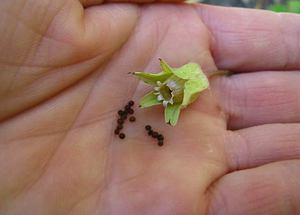 When choosing seeds for sowing, it is necessary to take into account the conditions in which it is planned to grow this plant. For normal development, primrose needs to be kept cool.
When choosing seeds for sowing, it is necessary to take into account the conditions in which it is planned to grow this plant. For normal development, primrose needs to be kept cool.
Therefore, the optimum temperature for it will be no higher than 10 degrees. By fulfilling this condition, you can extend the flowering period of the primrose.
If you plan to grow these flowers in an apartment, then you can use as a seed primrose seeds.
When choosing seeds, it is necessary to take into account their shelf life and storage conditions. If they are purchased several months before sowing, then the seeds are kept in the refrigerator... Such treatment increases seed germination. In addition to seeds, you will need a soil mixture of the optimal composition, as well as fertilizer.
Seed stratification
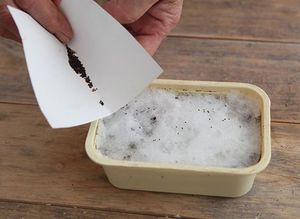 Since primrose has a special biological rhythm, this imposes certain restrictions on its cultivation from seeds. Given that it begins to bloom after the snow melts, care must be taken to ensure that the primrose is in an active state long before this moment.
Since primrose has a special biological rhythm, this imposes certain restrictions on its cultivation from seeds. Given that it begins to bloom after the snow melts, care must be taken to ensure that the primrose is in an active state long before this moment.
When sowing seeds in open ground, which is usually planned in April or May, this rhythm is disturbed. The solution here may be creation of conditions, as close to natural as possible.
This can be helped by such an operation known to many summer residents as stratification. Although it can be carried out in different ways, however, in general, its essence boils down to the fact that first the seeds are placed in a damp cloth until they swell at room temperature, after which they transferred to a cold place.
Here, conditions will be created for them, similar to those when they are under snow cover. At home, stratification can be done in the refrigerator. For owners of a private house, a cellar or a canopy can be its replacement.
What are the ways to carry out seed stratification
You can enjoy the flowering of primrose in early spring only if you start sowing seeds in mid-January.
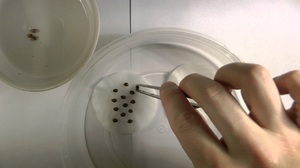 The first step is to hold the seeds for several days on a light windowsill.
The first step is to hold the seeds for several days on a light windowsill.- Next, they are placed in a bag with moist soil, which is placed in the refrigerator.
- In about two weeks, it will be time to place the seedlings on the windowsill. However, it must be protected from direct sunlight.
- Sometimes the seeds show no signs of life after a few weeks. In this case, the germination processes can be stimulated by moving the bag into the freezer, in which the temperature must be maintained at - 10 degrees.
It is important to ensure that the soil in the bag is constantly wet... In this case, seed germination occurs after 10 days.
Seed stratification can be done in a slightly different way.
- To prepare seeds for sowing and increase the percentage of germination, you can place them in a solution of potassium permanganate for three minutes, and then hold them in water for a day.
- When the seeds are swollen, they are sown in peat pots or boxes with garden soil. You need to place them in the soil to a depth that should correspond to the size of the seeds themselves. After sowing, small seeds should be lightly sprinkled with a layer of soil.
- To make the moisture less evaporated, a film is stretched over the boxes, after which they are transferred to a cold place.
- In the future, the soil must be constantly kept moist.
Sponge stratification method
If the first two methods of stratification did not fit for some reason, then the seeds can be prepared for sowing like this.
- If the primrose seeds purchased for sowing are rather small or there are a lot of them, then certification can be done with a sponge. First, you need to cut it a little so that longitudinal grooves are obtained. It is in them that the seeds are placed.
- The sponge should be placed on a tray or plate, after filling it with water.
- During the entire growing time, it is necessary to ensure that the sponge is moist. It is necessary to create the coolest conditions for the seeds.
- It is best to use a sponge with the smallest pores for sowing small seeds. However, if it turns out that the seeds are still very different from the pore diameter, then you can put fabric tabs in them before placing them in the cuts.
Seedling care
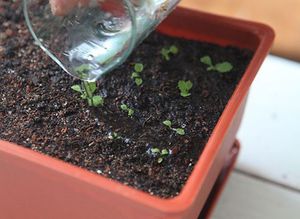 When the first two true leaves are formed in the seedlings, a pick is carried out.Two days after the pick, the seedlings begin to harden. This must be done only if it is planned to subsequently be transplanted to the site.
When the first two true leaves are formed in the seedlings, a pick is carried out.Two days after the pick, the seedlings begin to harden. This must be done only if it is planned to subsequently be transplanted to the site.
It needs to be taken out into the shade and the bag should be slightly opened. After about 10 days, when the seedlings get used to the fresh air, the polyethylene is completely removed.
From this point on, the seedlings are grown in a cool place, continuing keep the soil moist... Watering should be done very carefully, using, for example, a pipette.
Also, young seedlings of primrose also need feeding. Will be sufficient apply special fertilizers once a week. When warmer weather sets in, the seedlings can be left on the open balcony for one day.
However, in the evening it needs to be brought inside again. A favorable moment for transplanting seedlings to a permanent place occurs after the last frost. The easiest way to remove the sprouts from the sponge is with tools such as a toothpick, knitting needle, or wire. It is not necessary to make a pick in relation to these sprouts.
Primrose from seeds harvested in the garden
 The easiest way to grow stemless primrose from seeds is to prepare planting material from already growing primrose bushes in your area.
The easiest way to grow stemless primrose from seeds is to prepare planting material from already growing primrose bushes in your area.
For example, you can arrange a beautiful primrose flower bed under an old tree. Then it will bloom every spring and provide you with seeds.
Naturally, in terms of their varietal qualities, they will differ from maternal, however, the main thing is that they will be able to delight the gardener with a more original color.
- until the day of sowing comes, primrose seed pods must be kept at a temperature of about 7 degrees Celsius;
- keeping them cool for some time, pretty soon fresh seeds begin to germinate;
- further, they must be transferred to the refrigerator, where they must be in a container for 2-3 weeks;
- then the moment comes to transfer them to a bright window, however, they need to be protected from direct sunlight.
During storage, the seeds can be affected by fungi and diseases. This can be avoided if, before sowing them treat with special preparations.
However, this operation can be omitted for seeds purchased at the store. You just need pickle soilin which sowing will be carried out. With regard to seeds collected in his garden, he acts by analogy with store seeds.
Transplanting seedlings to a permanent place
 When the seedlings reach the state that they can be transplanted to a permanent place, it is recommended choose a suitable site for her. The stemless primrose will grow best in partial shade.
When the seedlings reach the state that they can be transplanted to a permanent place, it is recommended choose a suitable site for her. The stemless primrose will grow best in partial shade.
Before transferring the seedlings to the holes, they must be filled with compost and mineral fertilizer. If heavy soils prevail on the site selected for transplanting, then it will not hurt add leaf land.
The largest specimens should be placed no closer than 30-40 cm from each other. Smaller plants can be planted at a distance of 10-15 cm.
Primrose is one of the most popular and well-known perennials that can be easily grown not only in the open field, but also at home.
The easiest way to get new plants is by dividing the bush, however, when the mother plant is absent, you can also use a more time-consuming method - sowing stemless primrose seeds.
Growing from seeds involves their preparation, for which stratification is carried out. This operation allows to increase germination seeds, making them more resistant to disease.
It is very important to correctly determine the time for transplanting to a permanent seedling site. This should be done when the last frost has passed. In this case, with appropriate care, young primrose bushes will be able to bloom in the same year.
